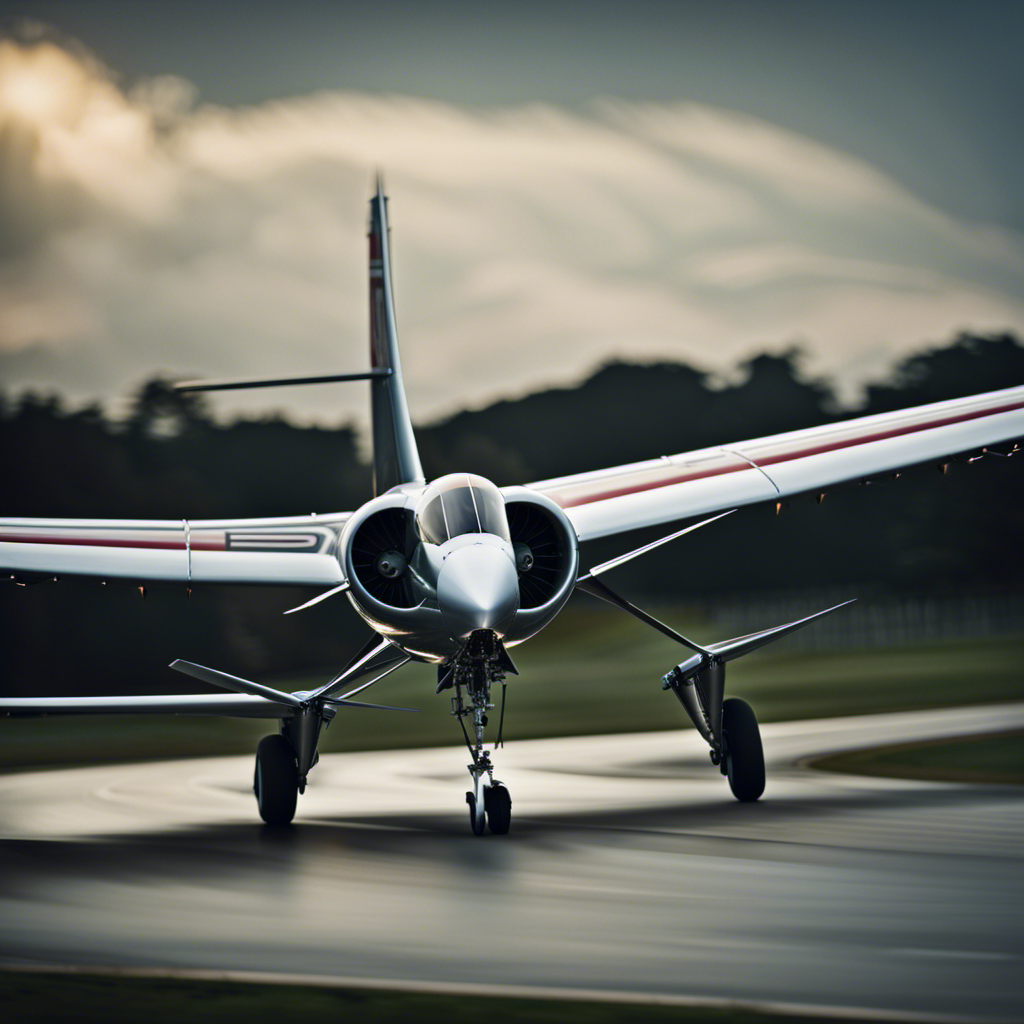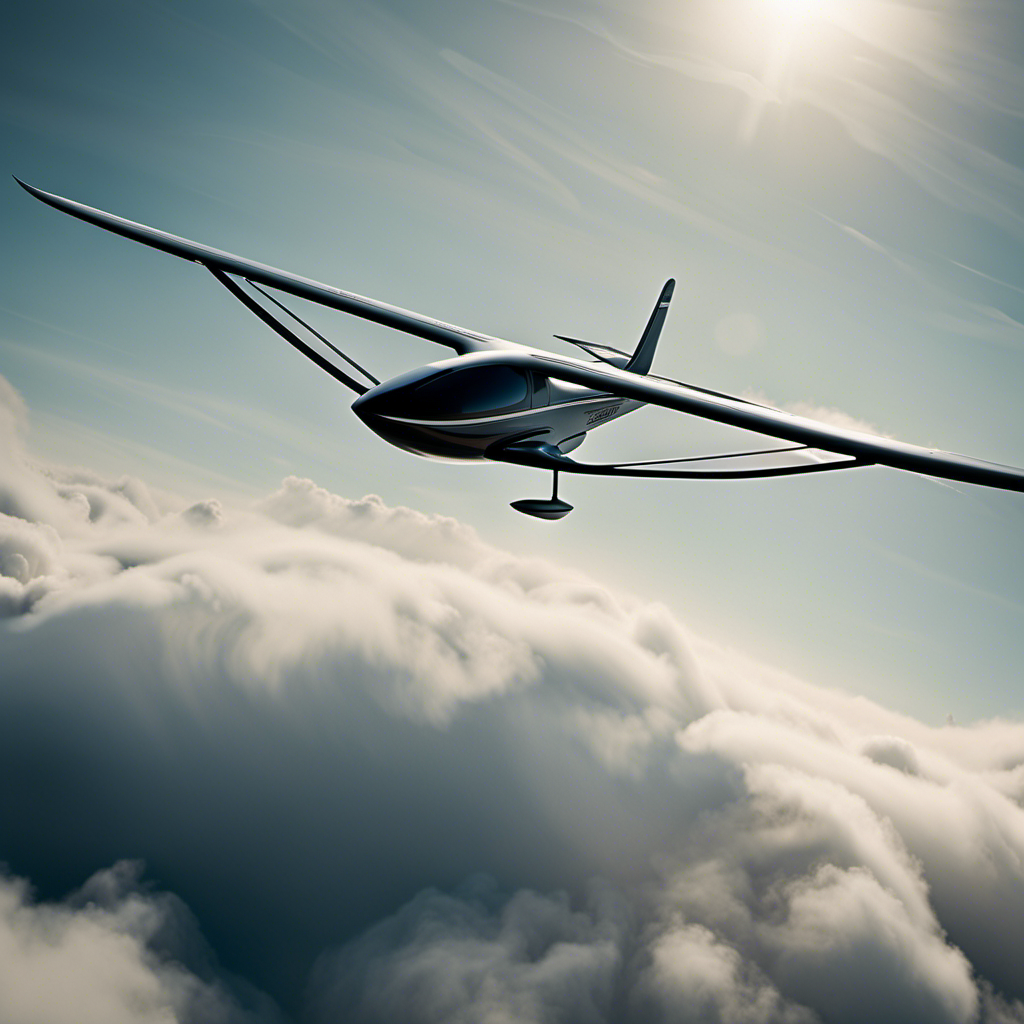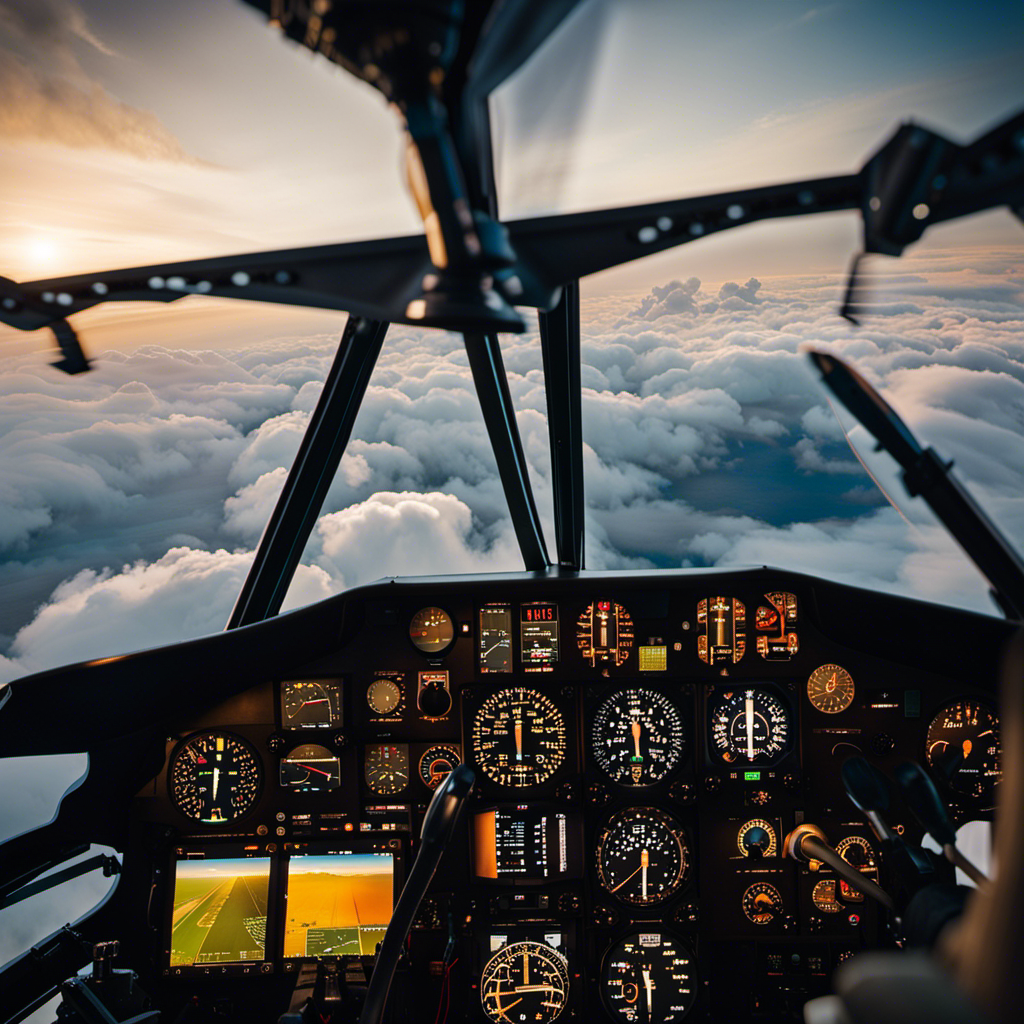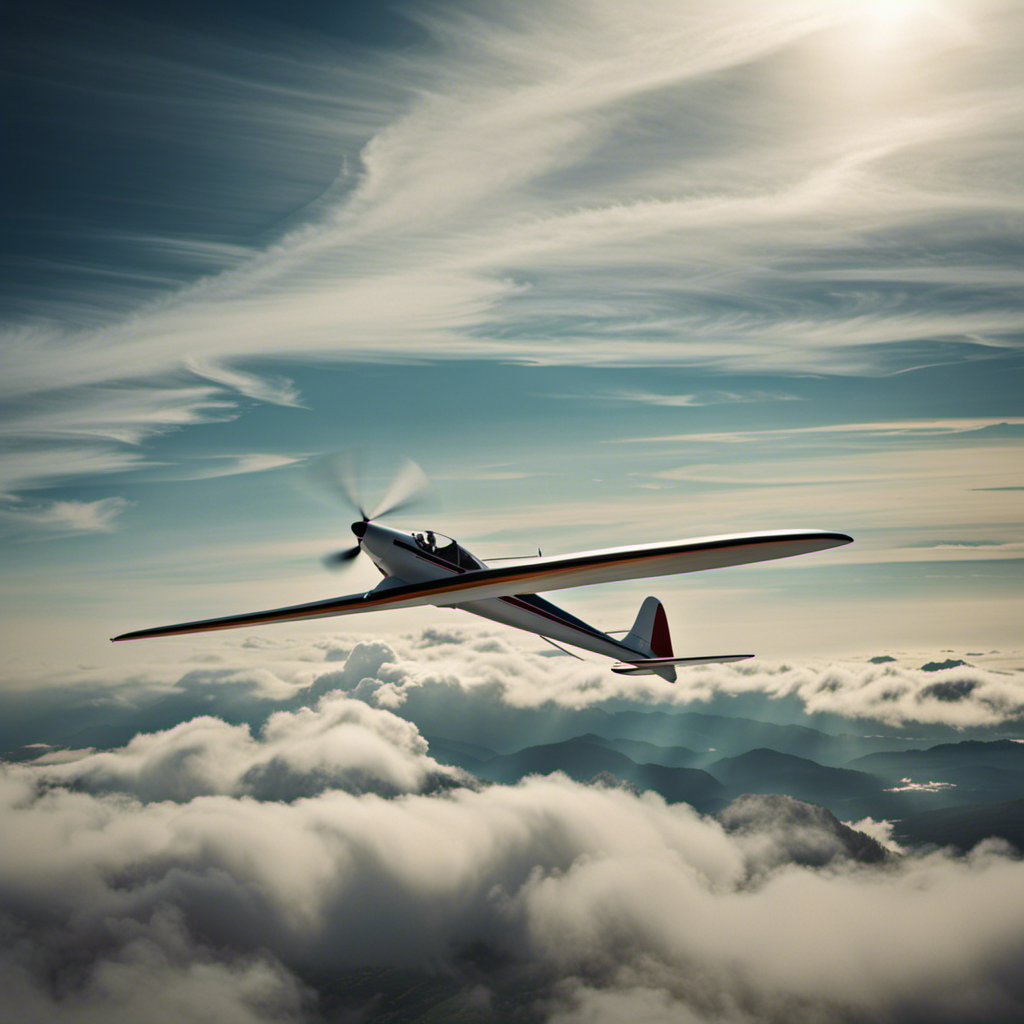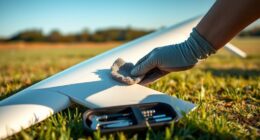Are you ready to discover the fascinating world of sailplanes? Brace yourself for an exciting journey as we explore the intricate mechanics that enable these amazing feats of aviation.
Prepare to be amazed as we explore the secrets of lift and drag, the role of airfoils, and the art of controlling pitch, roll, and yaw.
Get ready to soar as we delve into the world of thermals and updrafts, and discover the latest advancements in glider technology.
It’s time to experience the thrill of gliding and unlock the freedom of the sky.
Key Takeaways
- Gliding safety and training are crucial for ensuring safe operations, and include procedures, protocols, and knowledge of potential risks and mitigation strategies.
- Advancements in glider technology have led to stronger and lighter materials like carbon fiber composites, improved wing designs, and sophisticated avionics systems for real-time data, enhancing overall performance and safety.
- Improved materials such as carbon fiber composites revolutionize glider construction, providing greater strength, maneuverability, and efficiency.
- Advanced aerodynamics, including improved wing designs and features like winglets, result in enhanced glider performance, longer flights, and increased efficiency.
Basic Principles of Flight
To understand how a gliding plane works, you need to grasp the basic principles of flight.
When an aircraft is in motion, it experiences four forces: lift, weight, thrust, and drag. Lift is the upward force that opposes the aircraft’s weight and allows it to stay in the air. It is generated by the shape of the wings and the air flowing over them.
Drag is the resistance that opposes the aircraft’s motion through the air. It is caused by the friction between the aircraft and the air molecules.
Understanding the relationship between lift and drag is crucial in comprehending the mechanics of a gliding plane. Lift allows the aircraft to stay airborne, while drag determines the speed and distance it can travel.
Understanding Lift and Drag
You can understand lift and drag by considering the forces acting on the gliding plane.
Lift is the force that opposes the weight of the plane, allowing it to stay airborne. It is generated by the difference in air pressure between the upper and lower surfaces of the wings. The curved shape of the wings, known as airfoils, plays a crucial role in creating this pressure difference.
As air flows over the curved upper surface of the wing, it moves faster, creating a lower pressure compared to the flat lower surface. This pressure difference results in an upward force, which is lift.
Drag, on the other hand, is the resistance the plane encounters as it moves through the air. It is caused by the friction between the plane and the air molecules and is influenced by factors like the shape, size, and speed of the plane.
Understanding how lift and drag interact is fundamental to comprehending the mechanics of a gliding plane. By examining the role of airfoils, we can delve deeper into the complexities of flight.
The Role of Airfoils
Understanding the role of airfoils is crucial in comprehending how lift and drag interact in the mechanics of flight. Airfoils are specially designed shapes that create lift when air flows over them.
Here’s what you need to know:
- Airfoils are curved on the top and flat on the bottom, which creates a pressure difference that generates lift.
- The angle of attack, or the angle at which the airfoil meets the oncoming airflow, affects the amount of lift generated.
- The camber, or the curvature of the airfoil, can be adjusted to optimize lift and minimize drag.
By understanding the principles behind airfoils, you can appreciate how they enable planes to stay aloft.
Now, let’s explore the next section on gravity and weight in gliding, where we’ll delve into another important aspect of flight.
Gravity and Weight in Gliding
Now, let’s take a look at how gravity and weight play a role in gliding.
When you’re gliding, gravity is the force that pulls you downwards towards the Earth. The weight of the glider, which is the force exerted by gravity on the mass of the aircraft, affects its overall performance. It determines how fast the glider descends and how quickly it can gain altitude.
The distribution of weight also affects the stability of the glider, as it determines the center of gravity. Maintaining a proper balance between the glider’s weight and the lift generated by the wings is crucial for a safe and efficient glide.
Understanding the relationship between gravity and weight is essential before we delve into controlling pitch, roll, and yaw, which are key aspects of gliding.
Controlling Pitch, Roll, and Yaw
To control the pitch, roll, and yaw of the glider, you’ll need to manipulate the control surfaces. These surfaces include the elevator, ailerons, and rudder.
The elevator controls the pitch, allowing the glider to climb or descend. By moving the elevator up or down, you can change the angle of attack and control the glider’s altitude.
The ailerons control the roll, enabling the glider to bank left or right. When you move the ailerons, one goes up while the other goes down, creating a difference in lift and causing the glider to roll.
Lastly, the rudder controls the yaw, allowing the glider to turn left or right. By moving the rudder, you can control the direction of the glider.
Mastering these control surfaces is crucial for a successful flight.
Now, let’s delve into the launching and landing techniques.
Launching and Landing Techniques
When launching a glider, it’s important to ensure proper airspeed and technique.
Begin by positioning the glider into the wind, allowing for maximum lift during takeoff.
Apply full backpressure on the control stick to maintain a nose-high attitude.
As the glider gains speed, gently release the backpressure to allow the glider to smoothly transition into level flight.
Keep a keen eye on the airspeed indicator, ensuring it remains within the appropriate range.
The correct technique during launch will result in a smooth and efficient ascent.
Once in the air, the glider is ready to explore the dynamics of thermals and updrafts, which provide opportunities for sustained flight and altitude gain without the need for a motorized propulsion system.
These natural air currents are essential for glider pilots to extend their flight time and explore the vast possibilities of soaring.
Thermals and Updrafts
You’ll find that thermals and updrafts are natural air currents that play a crucial role in extending your flight time and gaining altitude without the need for a motorized propulsion system. Understanding how to utilize these atmospheric phenomena is essential for maximizing your gliding experience. Thermals are columns of warm air that rise from the ground due to uneven heating caused by the sun. Updrafts, on the other hand, are localized areas of rising air that can occur near features such as mountains or cliffs. By soaring within these air currents, you can stay aloft for extended periods and even climb to higher altitudes. The following table illustrates the key characteristics of thermals and updrafts:
| Thermals | Updrafts |
|---|---|
| Warm air rising from the ground | Rising air near mountains or cliffs |
| Caused by uneven heating from the sun | Can be triggered by wind hitting a slope |
| Can extend your flight time | Provides an opportunity to gain altitude |
Understanding how to identify and make use of thermals and updrafts is crucial for glider pilots. It allows you to stay airborne for longer periods, explore new areas, and experience the freedom of unpowered flight. However, it is important to remember that flying in thermals and updrafts requires skill and experience. Gliding safety and training will equip you with the necessary knowledge to navigate these air currents effectively, ensuring a safe and enjoyable flight. So, let’s now delve into the next section and explore the essential aspects of gliding safety and training.
Gliding Safety and Training
Learning about the safety and training aspects of gliding is essential for pilots to ensure a safe and enjoyable flight experience. As a pilot, you must be well-versed in the procedures and protocols that govern gliding operations. This includes understanding the pre-flight checks, emergency procedures, and communication protocols.
Safety is paramount, and you should be knowledgeable about the potential risks and how to mitigate them. Training is crucial to develop the necessary skills and knowledge required for gliding. You will learn about aerodynamics, weather patterns, navigation techniques, and emergency landings.
Advancements in Glider Technology
To fully embrace the exciting advancements in glider technology, you must stay updated on the latest developments and innovations. Glider technology has come a long way in recent years, pushing the boundaries of what is possible in terms of performance and safety.
Here are some key developments to keep an eye on:
-
Improved materials: Stronger, lighter materials such as carbon fiber composites have revolutionized glider construction, allowing for greater strength and maneuverability.
-
Advanced aerodynamics: Improved wing designs and aerodynamic features like winglets have enhanced glider performance and efficiency, enabling longer and faster flights.
-
Integrated avionics: Modern gliders are equipped with sophisticated avionics systems that provide real-time data on weather conditions, airspace, and navigation, enhancing the pilot’s situational awareness.
-
Electric propulsion: Electrically powered gliders are becoming more prevalent, offering quieter and more environmentally friendly flight options.
-
Safety innovations: Innovations in safety systems, such as parachute recovery systems and cockpit airbags, have improved the overall safety of gliders.
By staying informed about these advancements, you can maximize your gliding experience and take full advantage of the incredible opportunities that await you in the sky.
Transition: Now that you are up to date with the latest advancements in glider technology, let’s delve into the exhilarating world of gliding and experience the freedom of the sky.
The Thrill of Gliding: Experiencing the Freedom of the Sky
Now that we’re up to date with the latest advancements in glider technology, let’s experience the exhilarating freedom of the sky.
Gliding, also known as soaring flight, is a remarkable accomplishment of engineering and aerodynamics. When you step into a glider, you become one with the elements, relying solely on the forces of nature to propel you through the air.
As you release from the tow plane and feel the rush of the wind beneath your wings, you will witness the true beauty of gliding. With precise control and skillful maneuvering, you can navigate the sky, rising on thermals and gliding effortlessly through the air.
The thrill of gliding is unparalleled, as you become part of the vast expanse of the sky, embracing the freedom and serenity that only gliding can offer.
Conclusion
Congratulations! You’ve now delved into the intricate workings of a gliding plane, uncovering the secrets of flight. By understanding the principles of lift and drag, the role of airfoils, and the influence of gravity and weight, you’ve grasped the art of gliding.
With the ability to control pitch, roll, and yaw, you’re ready to soar through the sky with grace and precision. Remember to navigate thermals and updrafts, and always prioritize safety and training.
Embrace the advancements in glider technology, and prepare to experience the thrilling freedom of the sky. Fly high, my friend!
